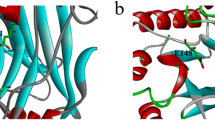Abstract
α-Chymotrypsin was covalently modified with cellobiose by chemical means. After adsorption on to a porous polyamide support, both the native and the glycosylated immobilized derivatives were used to synthesize a kyotorphin derivative (N-benzoyl-l-tyrosyl-l-argininamide) in acetonitrile/water. Glycosylated chymotrypsin gave a 125% increase in product formation (750 nmol mg−1 catalyst in 3 h) at 60% (v/v) acetonitrile/water. Maximal protective effect of this glycosylation process was at 70% (v/v) acetonitrile/water, at which concentration the half-life of the glycosylated enzyme was 20-times longer than that of the native form (52 min and 2.8 min, respectively).
Similar content being viewed by others
References
Clapés P, Adlercreutz P, Matiasson B (1990) Enzymatic peptide synthesis in organic media: nucleophile specificity and medium engineering in α-chymotrypsin-catalyzed reactions. Biotechnol. Appl. Biochem. 12: 376–386.
Khmelnitsky YL, Mozhaev VV, Belova AB, Sergeeva MV, Martinek, K (1991) Denaturation capacity: a new quantitative criterion for selection of organic solvents as reaction media in biocatalysis. Eur. J. Biochem. 198: 31–41.
Kudryashova EV, Gladilin AK, Vakurov AV, Heitz F, Levashov AV, Mozhaev VV (1997) Enzyme-polyelectrolyte complexes in water-ethanol mixtures: negatively charged groups artificially introduced into α-chymotrypsin provide additional activation and stabilization effects. Biotechnol. Bioeng. 55: 267–277.
Levitsky V, Lozano P, Gladilin A, Iborra JL (1998). Stability of immobilized enzyme-polyelectrolyte complex against irreversible inactivation by organic solvents. In: Ballesteros A, Plou FJ, Iborra JL, Halling P, eds. Stability and Stabilization of Biocatalysts. Progress in Biotechnology, Vol. 15. Amsterdam: Elsevier Science, pp. 417–422.
Lenders JP, Crichton RR (1984) Thermal stabilization of amylolytic enzymes by covalent coupling to soluble polysaccharides. Biotechnol. Bioeng. 26: 1343–1351.
Longo MA, Combes D (1997) Influence of surface hydrophilic/hydrophobic balance on enzyme properties. J. Biotechnol. 58: 21–32.
Lozano P, de Diego T, Iborra JL (1995) Effect of water-miscible aprotic solvents on kyotorphin synthesis catalyzed by immobilized α-chymotrypsin. Biotechnol. Lett. 17: 603–608.
Rariy RV, Klyachko NL, Borisova EA, Cortes-Penagos CJ, Levashov AV (1995) Lectin-like center in the molecule of α-chymotrypsin formation of complexes with peroxidase and artificially glycosylated α-chymotrypsin. Biochem. Molec. Biol. Int. 36: 31–37.
Timasheff SN (1998) Control of protein stability and reactions by weakly interacting cosolvents: the simplicity of the complicated. Adv. Prot. Chem. 51: 355–432.
Wartchow CA, Wang P, Bednarsky MD, Callstrom MR (1995) Carbohydrate-protease conjugates: stabilized proteases for peptide synthesis. J. Org. Chem. 60: 2216–2226.
Author information
Authors and Affiliations
Rights and permissions
About this article
Cite this article
Levitsky, V., Lozano, P. & Iborra, J. Glycosylated α-chymotrypsin as a catalyst for kyotorphin synthesis in water-organic media. Biotechnology Letters 21, 595–599 (1999). https://doi.org/10.1023/A:1005503429715
Issue Date:
DOI: https://doi.org/10.1023/A:1005503429715




